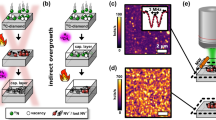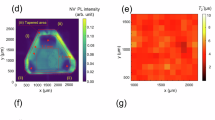Abstract
THE presence of nitrogen in diamond has provided an explanation for some of the variations which are observed in the physical properties of this material1–3. The nitrogen impurity can exist either as dispersed substitutional donors, in which case electron spin resonance is observed2, or as non-paramagnetic aggregates of atoms3. Absorption peaks in the infrared can be obtained from nitrogen in either form4. Peaks at 1,129 cm−1 and 1,345 cm−1, coupled by a broad saddle which is peaked at 1,290 cm−1, are characteristic of the paramagnetic centres. In contrast, aggregates of nitrogen give a single peak at 1,280 cm−1. Dyer et al.4 have shown that the two forms of nitrogen can be distinguished even if they co-exist in a particular specimen. In most cases, however, the nitrogen exists predominantly in one form and the diamond is classified either as type 1a or as type 1b. In type 1a diamond, the aggregates of nitrogen are in a majority and in type 1b diamond the concentration of dispersed nitrogen is the larger.
This is a preview of subscription content, access via your institution
Access options
Subscribe to this journal
Receive 51 print issues and online access
$199.00 per year
only $3.90 per issue
Buy this article
- Purchase on SpringerLink
- Instant access to full article PDF
Prices may be subject to local taxes which are calculated during checkout
Similar content being viewed by others
References
Kaiser, W., and Bond, W. L., Phys. Rev., 115, 857 (1959).
Smith, W. V., Sorokin, P. P., Gelles, I. L., and Lasher, G. J., Phys. Rev., 115, 1546 (1959).
Evans, T., and Phaal, C., Proc. Roy. Soc., A, 270, 538 (1962).
Dyer, H. B., Raal, F. A., Du Preez, L., and Loubser, J. H. N., Phil. Mag., 11, 763 (1965).
Smith, M. J. A., and Angel, B. R., Phil. Mag., 15, 783 (1967).
Author information
Authors and Affiliations
Rights and permissions
About this article
Cite this article
ANGEL, B., SMITH, M. & CHARETTE, J. Correlation between the Nitrogen Impurity Content and the Crystal Habit of Synthetic Diamond. Nature 218, 1246–1247 (1968). https://doi.org/10.1038/2181246b0
Received:
Issue date:
DOI: https://doi.org/10.1038/2181246b0



